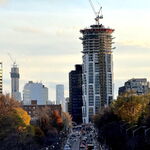MisterF
Senior Member
Nobody said that transit will eliminate the need for cars. Let's not resort to straw men here. A 400 extension wouldn't serve the type of traffic you describe is ideal for roads very well. It would serve suburb-to-downtown traffic, which as you say is better suited for transit. Madrid has far more investment in heavy rail than Toronto does, and is one example of how underdeveloped our rail transit system is. While Madrid's outer suburbs are served well by metro, Toronto's more sprawling suburbs are better served by upgraded regional trains.Many great cities have both though. Think Madrid for instance, it has a very extensive subway/commuter rail/light rail system that covers virtually all the urban area, it also has a very extensive motorway network including a short section of tunnel on the inner ring road (M-30). In cities with high investment in both, public transport and roads serve very different purposes, with transit largely serving travel to and within dense urban centres while roads serving more suburb to suburb traffic, travel to industrial areas and commercial vehicle/truck traffic. Transit will never come close to eliminating the need for cars. Typically cities like Madrid with excellent transit have about a 50-50 split between public transport and car travel.
While I don't think tearing down the Gardiner is necessary, it wouldn't cause major delays. There's not much through traffic on the Gardiner. Most of it is exiting onto downtown streets. Widening the DVP would be useless for relieving traffic and just cause more car traffic downtown and create new bottlenecks. Pedestrian scrambles are in places with heavy pedestrian traffic, where there are often more pedestrians than motorists, on top of rapid transit. You complain of car traffic jams, but what about pedestrian traffic jams? And finally, 2 lane roads with left turn lanes often run more smoothly than 4 lane roads without them. Intersection design is more important than the number of through lanes.Think the endless proposals to tear down the Gardiner, the cancellation of the Front Street Extension, the cancellation of proposals to widen the DVP from 3 to 4 lanes each way, the narrowing of 4 lane roads to 2 lanes + an underused bicycle lane, and the "pedestrian scrambles" downtown that create huge traffic jams.
London's greenbelt legislation and the age of its Underground have nothing to do with the lack of highways into its core. And if London built new highways to the core, its central streets would probably become even more congested and parking demand and prices would go up. My point remains - you can build a major world city without freeways going downtown.London is not an example that we want to emulate. Due to its terrible road network (worst of any major city in the developed world I think) and having the highest parking costs in the world and very high congestion charge people are basically forced to use London's extensive but very mediocre transit system despite overcrowding, endless technical problems on the tube, endless weekend tube maintenance, and high fares. Also London has an insanely high cost of living because of ridiculously strict greenbelt regulations, forcing people to commute very long distances to work.





